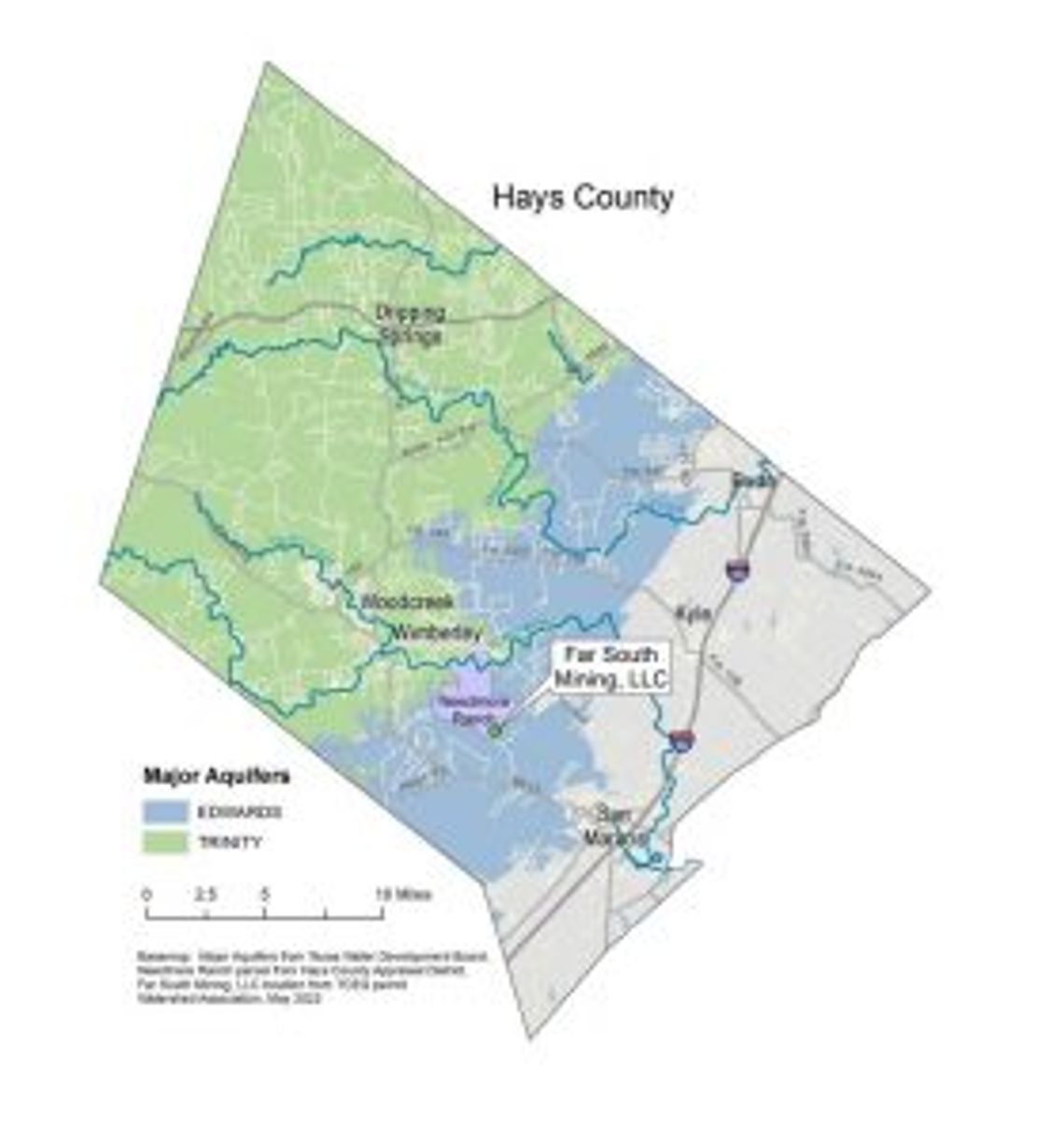By Megan Wehring
HAYS COUNTY – A proposed rock quarry and rock crushing operation is not receiving positive feedback from all sides.
The Trinity Edwards Springs Protection Association (TESPA) sent an amended Notice of Intent (NOI) to bring legal action against Far South Mining LLC (FSM) for a proposed rock quarry and rock crushing operation in Hays County. The NOI sent on Nov. 7 triggers a 60-day waiting period required by law before TESPA’s lawsuit against FSM can be filed in federal court.
This is the first amended version of the NOI distributed in May 2022, according to Karen Ford of WaterPR. As the legal team was preparing the case and court filing, they came across additional legal arguments to be included in the case, thus triggering the requirement for an amended notice.
TESPA is requesting FSM to abandon its plans for a rock quarry on the Needmore Ranch, located between Wimberley and San Marcos. The FSM permit request estimates the footprint of the operation to be 2,000 by 4,000 feet in size. That’s equivalent to 127 football fields of mining and land disruption on the Needmore Ranch in an area formerly known as “Little Arkansas.”
The Texas Commission on Environmental Quality has already approved the quarry permit for air quality. However, the 44-page NOI from TESPA cites numerous potential violations of federal rules including the Endangered Species Act, Clean Water Act and Safe Drinking Water Act.
According to the NOI, the proposed quarry and rock crushing operations pose threats of harm to federally protected endangered species and their designated critical habit through:
• Lowering of local groundwater and surface water levels from mining operations and dewatering.
• Changes in turbidity levels in groundwater/surface water due to blasting and quarry operations.
• Interruption of groundwater conduit flow paths by rock removal and/or blasting in karst systems.
• Temperature change (thermal impacts) in springs and surface water streams.
• Seismic impacts to endangered species.
• Impacts to groundwater/surface water quality from hazardous chemical spills and blasting residuals.
• Impacts from point and non-point sources of dust to surface water and groundwater from stormwater runoff and fugitive dust.
• Destruction of sensitive superficial karst features such as caves.
• Disruption of natural drainage patterns and stream morphology.
• Pollution from residues of nitrates and petroleum products accumulating in the stormwater runoff and groundwater from the ammonium nitrate blasting slurry and related activities.
• Leaks and spills of petroleum products from equipment as well as the risk of outright spills such as the 2,000-gallon spill of diesel.
TESPA asks for an injunction to prohibit the quarry/rock crushing activities because FSM has failed to apply for and obtain the permits required to comply with the Edwards Aquifer Act and regulations of the Edwards Aquifer Protection Program.
“Contamination of water by a limestone quarry is nothing new, but this situation is particularly dangerous because of the location, right on top of the recharge zone of the Edwards Aquifer, where the groundwater is very near the surface and very much in jeopardy,” said Jeff Mundy, attorney for TESPA. “This type of mining operation injects an explosive slurry mixture of ammonium nitrate and diesel fuel into the limestone. The residue of ammonium nitrate and diesel accumulates over time, contaminating the water supply. The city of Miami had multiple municipal water wells polluted from a limestone mining operation.
“Also, as area residents learned during the construction of the Permian Highway Pipeline as it attempted to drill under the Blanco River, fluids injected into holes in the karst such as this area are lost as they go into the voids in the karst,” Mundy added. “Injecting ammonium nitrates and diesel into the Edwards Aquifer Recharge Zone is a threat to our water.”
The NOI states that the quarry and rock crushing operation will likely cause harm, or “take,” of endangered species such as the Comal Springs Dryopid Beetle, Golden-cheeked Warbler, San Marcos Springs Salamander and Texas Blind Salamander. There is also the potential for contamination of groundwater and drinking water supplies from related activities that involve blasting, operation of heavy equipment, rock crushing and an estimated 100-plus truckload of rock per day on Hays County roads.
“Far South Mining’s plan for a quarry and rock crushing plant threatens to disrupt aquifer recharge and groundwater movement within our karst landscape,” said Jim Blackburn, TESPA board president. “It must be stopped.”
TESPA is concerned with ensuring that groundwater from the Needmore Ranch is not used for rock crushing operations. Needmore may only use groundwater pumped under its permit for agricultural irrigation and wildlife use, according to a previous settlement agreement reached with TESPA.
“We are in communication with the Barton Springs Edward Aquifer Conservation District management and our area elected local and state officials about our issues and concerns,” said Patrick Cox, TESPA executive director, in a news release. “We appreciate the vigilance of everyone in our community who wants to protect the quality and integrity of the environment and preserve the Texas Hill Country.”











